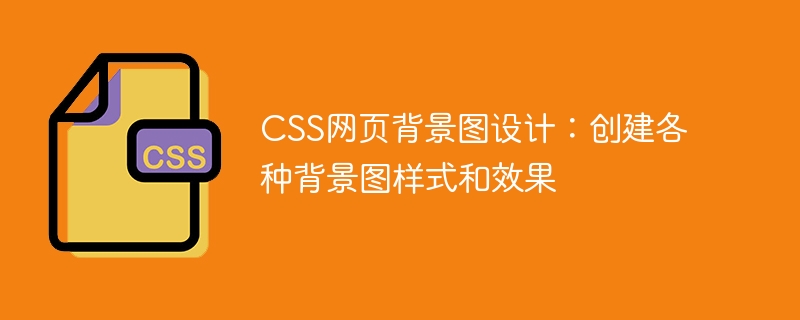

CSS web page background image design: creating various background image styles and effects requires specific code examples
Abstract:
In web design, background images are An important visual element that effectively enhances the attractiveness and readability of a page. This article will introduce some common CSS background image design styles and effects, and provide corresponding code examples. Readers can select and apply these background image styles and effects according to their own needs and preferences to achieve better visual effects and user experience.
Keywords: CSS, background image, design style, effect, code example
1. Introduction
Background image is an indispensable part of web design, it can provide the page with Increase visual depth and appeal. CSS provides a variety of ways to set web page background images, and various design styles and effects can be achieved through simple codes. The following will introduce several commonly used background image design styles and effects, as well as corresponding code examples.
2. Full-screen background image
Full-screen background image is a common design style that can bring a strong visual impact to the page by covering the entire browser window. The following is a CSS code example to implement a full-screen background image:
html,
body {
margin: 0;
padding: 0;
height: 100%;
}
.container {
background-image: url("background.jpg");
background-size: cover;
background-repeat: no-repeat;
height: 100%;
}In the above code, the height of the html and body elements is set to 100%, allowing them to occupy the entire browser window. Then, by adding a background image to the container element and setting the background size to cover, the background image will automatically scale to fit the size of the container to achieve a full-screen effect.
3. Tile background image
Tile background image is a simple and common design style. By continuously tile the background image to fill the entire container, you can create an interesting visual effect. . The following is an example of CSS code to implement a tiled background image:
.container {
background-image: url("background.jpg");
background-repeat: repeat;
}In the above code, by adding a background image to the container element and setting the background repetition mode to repeat, the background image will be repeatedly tiled in the container internal.
4. Fixed background image
Fixed background image is a special design style that sets the background image to a fixed position to remain motionless, thereby adding a stable and coherent look and feel to the page. The following is an example of CSS code to implement a fixed background image:
.container {
background-image: url("background.jpg");
background-attachment: fixed;
background-position: center;
}In the above code, by adding a background image to the container element, and setting the background attachment method to fixed and the background position to center, the background image will be fixed at Center position at the top of the page.
5. Gradient background image
Gradient background image is an excellent design style. By setting the background to a gradient color, you can bring a unique color change effect to the page. The following is a CSS code example to implement a gradient background image:
.container {
background: linear-gradient(to right, #00f, #f00);
}In the above code, by adding a background style to the container element and setting the background to a linear gradient from blue to red, the background image will appear Produces a color change effect from blue to red.
6. Summary
This article introduces several common CSS background image design styles and effects, and provides corresponding code examples. Readers can select and apply these background image styles and effects according to their own needs and preferences to achieve better visual effects and user experience. By rationally applying these CSS background image design techniques, we can create a variety of unique and beautiful web page backgrounds.
The above is the detailed content of CSS web background image design: create various background image styles and effects. For more information, please follow other related articles on the PHP Chinese website!